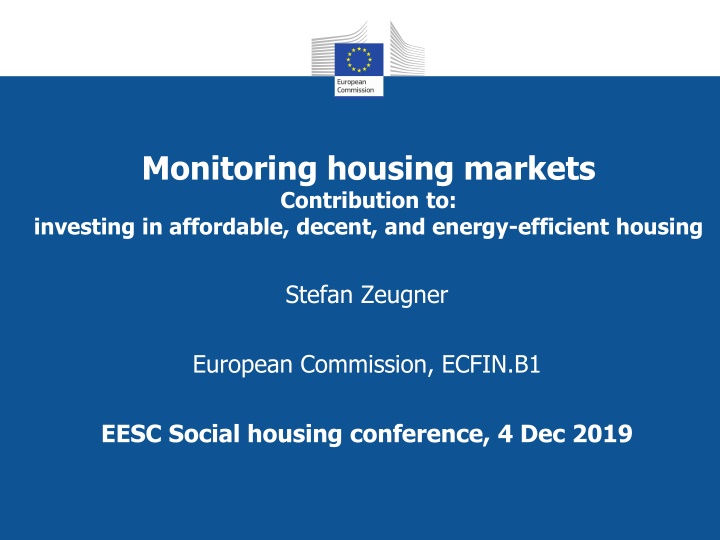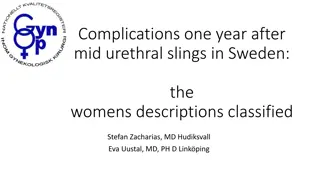
Monitoring Housing Markets for Affordable and Energy-Efficient Housing
"Explore the impact of monitoring housing markets on investing in affordable, decent, and energy-efficient housing, with a focus on Ireland's housing market trends before and after the 2007 financial crisis."
Download Presentation

Please find below an Image/Link to download the presentation.
The content on the website is provided AS IS for your information and personal use only. It may not be sold, licensed, or shared on other websites without obtaining consent from the author. If you encounter any issues during the download, it is possible that the publisher has removed the file from their server.
You are allowed to download the files provided on this website for personal or commercial use, subject to the condition that they are used lawfully. All files are the property of their respective owners.
The content on the website is provided AS IS for your information and personal use only. It may not be sold, licensed, or shared on other websites without obtaining consent from the author.
E N D
Presentation Transcript
Monitoring housing markets Contribution to: investing in affordable, decent, and energy-efficient housing Stefan Zeugner European Commission, ECFIN.B1 EESC Social housing conference, 4 Dec 2019
The MIP and housing: Ireland as an Illustration Irish boom until 2007 saw rapid expansion of credit flows, current account deficit, house prices. Slump let credit vanish, domestic demand and house prices decline, unemployment and NPL rise. 2
Prices and quantity?: Ireland Pre-crisis, prices increased fast, fueling construction investment After crisis slump, prices recovered, but construction investment much less Now smaller macro risks, prices good for banks/NPLs but serious affordability issue Data source: Ameco (for constr. inv.), ECFIN-BdF HOUSELEV (for prices) 3
The Macroeconomic Imbalance Procedure (MIP) in a nutshell MIP was designed to prevent such macroeconomic imbalances. MIP steps: 1. Annual reading of macro scoreboard 2. Conducting in-depth review of selected economies 3. Concluding whether imbalances, no imbalances or excessive imbalances exist 4. Preventive arm: Address MIP-relevant CSRs to country, follow up with Specific Monitoring Ireland was in an assistance programme 2011-13 Ireland is under MIP preventive arm since 4
Some remedies used during the crisis Make future credit boom less pronounced: Introduce macropru measures Reduce distortive incentives for household debt: clogged rental markets, interest-only loans, mortgage tax deductions Clean-up after the slump: Improve NPL resolution, insolvency systems, etc. Strong focus on funding-related regulation, and on countries surviving the crisis somehow. 5
The MIP and housing: Ireland as an Illustration Since 2013, house prices increase again (Also good for NPL). But this time it does not seem to be linked to credit, current account deficit. Data source: Eurostat 6
Current environment We have to remain vigilant for new bubbles Yet broadly, supply response to house price and rent increases remains timid This contributes to other macro imbalances: subdued investment, which means little help for inflation, EU current account surplus But also feeds into inequality which in turn depresses consumption Housing market requires lots of government intervention: make sure that this responds to what people need in face of trade-offs 7
Housing CSRs 2019 In 2019, 8 countries received housing-related country-specific recommendations (CSRs): Focus investment-related policy on supply of affordable housing: DE, IE, LV, LU, UK Focus investment-related policy on social housing: IE, SK Reduce home ownership bias of taxation: SE, NL Ensure functioning rental markets: SE, NL Bold denotes MIP-relevant recommendations 8
Affordability & macro-prudential policies Young families need loans to acquire housing, in particular when rental markets distorted and tax incentives for debt exist (Nordic/NL) Yet macropru policies try to disincentive taking debt: loan-to-value & loan-to-income restrictions, counter-cyclical capital buffers, risk weights Macropru policies directly reduce availability of loans bad for affordability Yet macropru also should impact overall prices negatively good for affordability 10
Affordability & environment Buildings are responsible for 36% of CO2* emissions in the EU, and key consumers of hydrocarbons Investment in residential energy efficiency key to reach climate objectives (and raise overall investment) Yet incentives mostly thru regulation so far (e.g., EPBD): Much focus on new construction, makes building new homes (considerably) more costly Moreover: SDG objective on land consumption, 11
Affordability & investment Investment in housing AND related infrastructure improves affordability, in theory Seems to hold in practice, though effect difficult to disentangle from building and credit booms Investment in housing has overall connotation of being unproductive Yet, major urban centres are where productivity happens. Adding workers that can capture value- added would be Pareto-efficient It s key where new homes are built 12
Affordability & rental markets Rental markets are key to provide housing to young and/or mobile people find housing Yet in most countries they are very limited, at least officially Rental caps can foster insider/outsider structure and deter new investment. Prime example: pre- crisis Portugal. Rental market segmentation affects affordability overall. 13
Housing markets by tenant in EU Note that social housing in NL, SE, DK is mostly classified as market price 14
Affordability & social housing policy Dutch/Nordic social housing model: selective / unequal, Massive profits in social housing sector, Little impact on private rental market. But FR? DE/AT/BE experience: wide variety of social support models may be more flexible UK/DE/Eastern experience: selling off perhaps good for correcting distortions. But shifting from supply to demand support has impact on rents Preliminary conclusions: social demand vs social supply policy has an impact on wider affordability Social housing intervention should aim at anchoring the private rental market 15
Affordability & political economy The ones who already live there are the core voters Well-off voters most likely to gain from increasing land prices NIMBYism is real. The more local planning decisions, the less elastic the housing supply Real estate developers (including social ones) seem to have strong impact on regulation Adressing market busts often still inadequate (insolvency, collateral enforcement etc.) Housing markets are key for banks in many Member States 16
Conclusions MIP concerned with housing markets that impact macroeconomic imbalances and stability In general, housing market is a key battleground for many EU objectives Functioning housing market needs both private markets and strong government intervention, due to market failures and political economy constraints There are many trade-offs to consider: Yet what about urban transport? 17
merci go raibh maith agat hvala grazie paldies a i k sz n m ni ik ajr dank u dzi kuj obrigado mul umesc akujem hvala kiitos tack gracias d kuji tak danke t nan thank you 18
AMR Scoreboard November 2018 Table 1.1: MIP Scoreboard 2017 Employment indicators External imbalances and competitiveness Internal imbalances Current account balance - % of GDP (3 year average) Net international investment position (% of GDP) Real effective exchange rate - 42 trading partners, HICP deflator (3 year % change) Export market share - % of world exports (5 year % change) Nominal unit labour cost index (2010=100) (3 year % change) House price index (2015=100), deflated (1 year % change) Private sector credit flow, consolidated (% of GDP) Private sector debt, consolidated (% of GDP) General government gross debt (% of GDP) Unemployment rate (3 year average) Total financial sector liabilities, non- consolidated (1 year % change) Activity rate - % of total population aged 15-64 (3 year change in pp) Long-term unemployment rate - % of active population aged 15-74 (3 year change in pp) Youth unemployment rate - % of active population aged 15-24 (3 year change in pp) Year 2017 5% (EA) 11% (Non-EA) 9% (EA) 12% (Non-EA) Thresholds -4/6% -35% -6% 6% 14% 133% 60% 10% 16.5% -0.2 pp 0.5 pp 2 pp -0.3 52.6 0.9 3.9 1.1 1.5p -1.5 187.0 103.4 7.8b 0.7 0.3b -0.8b -3.9b BE 3.1 -42.8 -3.3 19.4 13.6p 6.2 6.2 100.1 25.6 7.7 1.1 2.3 -3.5 -10.9 BG 1.0 -26.5 5.4 8.2 5.9 9.1p 4.1 67.4 34.7 4.0 22.9 2.4 -1.7 -8.0 CZ 8.1 56.3 -2.1 0.5 3.0 3.2 -1.4 204.0 36.1 6.0 4.1 0.7b -0.4b -1.6 DK 8.4 54.0 -2.5 6.5 5.1 2.9 4.9 100.1 63.9 4.2 4.0 0.5 -0.6 -0.9 DE 2.3 -31.4 2.9 2.6 12.4 1.8 3.6 106.4 8.7 6.3 9.7 3.6 -1.4 -2.9 EE 2.9 -149.3 -6.2 64.4 -17.2 9.5p -7.5 243.6 68.4 8.4 4.3 0.9 -3.6 -9.0 IE -0.8 -142.5 -2.8 -10.0 -1.0p -2.2e -0.8p 116.4p 176.1 23.3 -12.9 0.9 -3.9 -8.8 EL 1.8 -83.8 -2.5 9.8 0.0p 4.5 0.2p 138.8p 98.1 19.6 4.0 -0.3 -5.2 -14.6 ES -0.6 -20.1 -2.9 2.7 1.3p 1.8 7.0p 148.2p 98.5 10.0 4.3 0.5 -0.3 -1.9 FR 3.6 -62.4 0.0 20.0 -4.3d 2.8 1.2 98.4 77.5 13.5 3.9 0.3 -5.5 -17.7 HR 2.3 -5.3 -3.1 2.0 1.1 -2.0p 2.1 110.5 131.2 11.6 4.3 1.5 -1.2 -8.0 IT -5.0 -121.5 -6.6 6.9 -2.7p 1.3p 8.7p 316.3p 96.1 13.0 -2.3 -0.4 -3.2 -11.3 CY 0.6 -56.3 1.7 7.8 14.7 5.5 0.3 83.5 40.0 9.4 6.1 2.4 -1.3 -2.6 LV -0.7 -35.9 2.3 9.7 16.0 5.4 3.7 56.1 39.4 8.0 14.0 2.2 -2.1 -6.0 LT 5.0 47.0 -0.9 25.2 7.1 4.1 -15.5 322.9 23.0 6.1 -1.7 -0.6 0.5 -6.9 LU 4.0 -52.9 0.1 11.3 6.7 3.3 0.9 71.4 73.3 5.4 -8.0 4.2 -2.0 -9.7 HU 8.4 62.6 -2.3 11.2 1.7 4.1p 2.9 120.2 50.9 5.2 4.7 4.4 -1.1 -1.2 MT 8.3 59.7 -1.6 1.2 -0.2p 6.0 3.0p 252.1p 57.0 5.9 2.0p 0.7 -1.0 -3.8 NL 2.1 3.7 0.3 2.3 3.7 3.5 4.3 122.5 78.3 5.7 1.8 1.0 0.3 -0.5 AT -0.3 -61.2 -3.4 28.4 4.5p 1.7 2.7 76.4 50.6 6.2 6.3 1.7 -2.3 -9.1 PL 0.4 -104.9 -0.7 14.6 3.5p 7.9 1.3p 162.2p 124.8 10.9 1.8 1.5 -3.9 -10.9 PT -2.2 -47.7 -5.5 37.0 11.9p 4.0 1.7p 50.8p 35.1 5.9 8.1 1.6 -0.8 -5.7 RO 5.7 -32.3 -2.0 18.6 3.4 6.2 0.8 75.6 74.1 7.9 5.1 3.3 -2.2 -9.0 SI -2.0 -65.6 -1.9 6.7 6.9 4.4 5.9 96.1 50.9 9.8 17.9 1.8 -4.2 -10.8 SK -0.7 2.4 -2.6 -4.3 -2.5 0.5 8.2 146.4 61.3 8.9 -3.8 1.3 0.2 -0.4 FI 4.0 1.8 -5.4 -4.3 3.7 4.6 13.1 194.4 40.8 7.0 6.8 1.0 -0.2 -5.1 SE -4.6 -8.6 -10.7 -1.0 5.4 2.4 8.4 169.0 87.4 4.8 -1.6 0.9 -1.1 -4.9 UK Figures highlighted are the ones at or beyond the threshold. Flags: b: Break in series. d: Definition differs. e: Estimated. p: Provisional. 1) For the employment indicators, see page 2 of the AMR 2016. 2) House price index e = source NCB for EL. 3) For Nominal unit labour cost HR, d: employment data use national concept instead of domestic concept. 4) Unemployment rate, Activity rate, Long-term unemployment rate and Youth unemployment rate: BE: Revision in the survey methodology; IE: introduction of the new Labour Force Survey in substitution to the Quarterly National Household Survey as data source; DK: data collection improvement, introduction of computer-assisted web interviewing. ? ? ? ? Source: European Commission, Eurostat and Directorate General for Economic and Financial Affairs (for Real Effective Exchange Rate), and International Monetary Fund data, WEO (for world volume exports of goods and services) 19






















